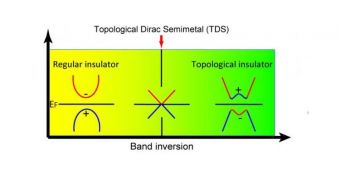Investigators with the US Department of Energy's (DOE) Lawrence Berkeley National Laboratory (Berkeley Lab), in California, announce that a material called sodium bismuthate can exist in a form of quantum matter that is essentially a 3D version of graphene.
This represents the first time three-dimensional topological Dirac semi-metals (3DTDS) are discovered in reality. This class of advanced materials was only proposed recently, and scientists believed they were still some time away from actually identifying or synthesizing them in real-life.
Graphene is a 2D material with a thickness of just one atom. It boasts a hexagonal, chicken lattice-like structure that is made up entirely of carbon atoms. Graphene has been the topic of nearly 4,000 studies since 2004, and has a wide range of sought-for physical and chemical properties.
Alongside topological insulators – materials that allow current to flow at their surface, but act as an insulator inside – graphene is one of the most well-studied and interesting compounds in materials sciences today. Not too long ago, theorists proposed that 3D versions of graphene could exist.
Berkeley Lab researcher Yulin Chen, who first proposed this investigation, says that the newly-discovered form of quantum matter will soon enable engineers to develop much faster transistors and far more compact hard drives for data storage.
The study is also the first to confirm the presence of 3D Dirac fermions (quarks, leptons, baryons and many atomic nuclei that are not their own antiparticles) inside sodium bismuthate. “A 3DTDS is a natural three-dimensional counterpart to graphene with similar or even better electron mobility and velocity,” Chen explains. The expert is now based at the University of Oxford, in the United Kingdom.
“Because of its 3D Dirac fermions in the bulk, a 3DTDS also features intriguing non-saturating linear magnetoresistance that can be orders of magnitude higher than the materials now used in hard drives, and it opens the door to more efficient optical sensors,” he adds. The physicist initiated the new study while working at the Berkeley Lab Advanced Light Source (ALS) installation.
Details of the research appear in a paper entitled Discovery of a Three-dimensional Topological Dirac Semimetal, Na3Bi, which is published in the latest issue of the top journal Science. The ALS facility was used because its beamline 10.0.1 installation is uniquely-suited for electron structure studies.
“ALS beamline 10.0.1 is perfect for exploring new materials, as it has a unique capability whereby the analyzer is moved rather than the sample for the ARPES measurement scans,” Chen explains.
“This made our work much easier as the cleaved sample surface of our material sometimes has multiple facets, which makes the rotating-sample measurement schemes typically employed for ARPES measurements difficult to carry out,” concludes the Berkeley Lab investigator.

 14 DAY TRIAL //
14 DAY TRIAL //